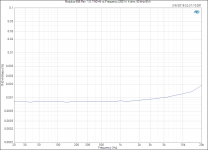Is aluminium better for chassis ? Yes, because it is a-magnetic.
Do massive aluminium offer a benefit ? I can see two, better temperature stability inside the enclosure and better calorie evacuation.
Dit it makes a huge difference ? I don't think so. But some people want the best quality everywhere they can and no one is surprised to see a limousine in Beverly hills.
[edit] Not to mention that it's more pleasurable to have a solid object that does not bend under your fingers rather than a plastic and thin sheet one that rust and is so light that it slips on its shelf when you press a button.
Do massive aluminium offer a benefit ? I can see two, better temperature stability inside the enclosure and better calorie evacuation.
Dit it makes a huge difference ? I don't think so. But some people want the best quality everywhere they can and no one is surprised to see a limousine in Beverly hills.
[edit] Not to mention that it's more pleasurable to have a solid object that does not bend under your fingers rather than a plastic and thin sheet one that rust and is so light that it slips on its shelf when you press a button.
Last edited:
OPA1642 make a rather fine MM phono stage with several fringe benefits 🙂
Bill -
I've wondered why no one bit on jcxs recommendation to run a 1644 in parallel. 2.7 nV/rtHz or so with very little effort or cost.
George, my brother did materials research for s little while at Boeing, so at one point I had a much greater appreciation for subtle alloy changes and heat treatment schedules. Albeit I don't remember anything he specifically talked about.
Tryphon, we're being ridiculous for ridiculous sake with some satire towards the extreme ends of gearphilia.
Plus we baited George into offering up more informative links. 🙂
Plus we baited George into offering up more informative links. 🙂
If I was one of those kinds of perpetually disappointed people, wouldn't I want enclosure made out of copper?But some people want the best quality everywhere they can

What I love about 47 labs is how much they got wrong and yet still had people praising it. It sort of encapsulates one section of boutique audio in one expensive flawed product 🙂
LOL.
If I was one of those kinds of perpetually disappointed people, wouldn't I want enclosure made out of copper?
We had a discussion a while ago about how much thinner one could go to block 50/60 Hz with cu billet vs aluminum. It wasn't much. Some folks didn't get the humor and got into why you should use steel enclosures and, if you must, the spring loaded fingers to ensure contact between faces.
Mind you, I think I'd prefer the aesthetics of gunmetal anodized aluminum above copper. Far less maintenance and need to reinforce floor joists to boot!
Depleted uranium should give your audio device that heft you're looking for to demonstrate it's of 6moons quality.
In DU you're going to see almost exclusively thermal neutrons, ergo warmth. You may be right for fast neutrons, especially in terms of tempo.
Radioactivity : Slow and fast neutrons
Radioactivity : Slow and fast neutrons
Yes and please do not forget that you need a perfect milled thick wall Al box + all the wires getting in through insulated connectors without any filtering to bring the interference el. field inside to enable capacitive coupling into the bare Ag wire nests, this makes just the true highend sound essence.
In DU you're going to see almost exclusively thermal neutrons, ergo warmth. You may be right for fast neutrons, especially in terms of tempo.
Radioactivity : Slow and fast neutrons
It's not the first time life threatening technology was proposed for audio (ozone from the ionized gas speakers).
liquid mercury cables?
I miss KBK and his galinstan cables.
Try again to scare me; THD @1KHz 80kHz BW 1W output power appears to be the same (0.002%, or -94dB) as the THD+N @1KHz 80KHz BW 45W output power. Noise appears to be negligible in your measurements, so that’s not it.
Meantime, it doesn’t pass the smell test, I’m not buying claims significantly better than the data sheet spec.
Enjoy smelling around:
LM3886 Done Right
And YES he did achieve better-than-spec-sheet performance!
And Tom's comp amp:
Modulus-86 R2.3: Composite amplifier. 65W (4Ω) @ 0.00006% THD
And Tom's new high power comp amp:
Neurochrome Modulus-686: 240W(8Ω); 360W(4Ω) @ 0.00025% THD+N

"Output power: 360 W (4 Ω) – 240 W (8 Ω).
Ultra-low 0.00025 % THD+N (140 W, 8 Ω, 1 kHz).
Ultra-low 0.00036 % THD+N (280 W, 4 Ω, 1 kHz).
Ultra-low noise: 25.0 µV (RMS, A-weighted, 20 Hz – 20 kHz)."

Enjoy your edumakation!
Cheers,
Jeff
Last edited:
Silly, Waly, 6061 is aerospace-grade aluminum.
6061 is a general purpose structural alloy with uses in aerospace, I use it in my chassis. It's relatively inexpensive compared to many other AL alloys, or was. 🙁 7000 series alloys are apparently stronger and some are heat treatable.
AL alloys are confusing to me. The only ones I have ever worked with are 2000 series and 6000 series.
- Status
- Not open for further replies.
- Home
- Member Areas
- The Lounge
- John Curl's Blowtorch preamplifier part III
